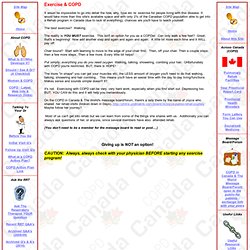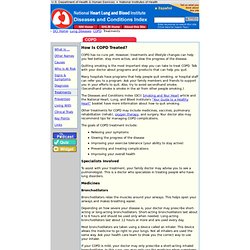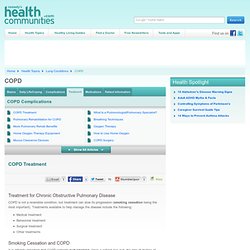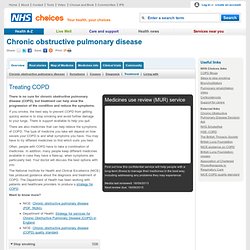

Inicio - SORECAR participa en la elaboración de GesEPOC. La novedad de GesEPOC reside en dos aspectos: por un lado, la voluntad de convertir el paciente en el eje de la actuación de los diferentes especialistas y, por otro lado, la voluntad de conseguir una amplia difusión entre todos los profesionales implicados en la atención de la EPOC y también entre los pacientes y la población en general.

Las sociedades e instituciones que van a participar en la redacción y difusión de la Guía GesEPOC son: Nuestra sociedad, con representación de la Dra Ester Marco (presidenta de SORECAR) ha participado activamente en la elaboración y difusión de la guía.
Systematic Reviews of Treatments for Chronic Obstructive Pulmonary Disease (COPD) COPD (Chronic Obstructive Pulmonary Disease) Chronic Obstructive Pulmonary Disease (COPD), Diagnosis and Management of (Guideline) COPD - Journal of Chronic Obstructive Pulmonary Disease. COPD forum. Diseases - COPD : Canadian Lung Association. Why Exercise With COPD? Exercise & COPD It would be impossible to go into detail the how, why, type etc re: exercise for people living with this disease.

It would take more than this site's available space and with only 2% of the Canadian COPD population able to get into a Rehab program in Canada (due to lack of everything), chances are you'll have to teach yourself. The best exercise? Walking. The reality is YOU MUST exercise. Chair bound? Put simply; everything you do you need oxygen. The more "in shape" you can get your muscles etc; the LESS amount of oxygen you'll need to do that walking, talking, showering and hair combing.. It's not. On the COPD in Canada & The World's message board/forum, there's a lady there by the name of Joyce who shared her rehab visits (broken down in Days).
Most of us can't get into rehab but we can learn from some of the things she shares with us. COPD Screener. Chronic obstructive pulmonary disease (COPD)treatments. COPD has no cure yet.

However, treatments and lifestyle changes can help you feel better, stay more active, and slow the progress of the disease. Quitting smoking is the most important step you can take to treat COPD. Talk with your doctor about programs and products that can help you quit. Many hospitals have programs that help people quit smoking, or hospital staff can refer you to a program. Ask your family members and friends to support you in your efforts to quit. The Diseases and Conditions Index (DCI) Smoking and Your Heart article and the National Heart, Lung, and Blood Institute's "Your Guide to a Healthy Heart" booklet have more information about how to quit smoking. Other treatments for COPD may include medicines, vaccines, pulmonary rehabilitation (rehab), oxygen therapy, and surgery.
The goals of COPD treatment include: Specialists Involved To assist with your treatment, your family doctor may advise you to see a pulmonologist. What Is COPD. COPD, or chronic obstructive pulmonary (PULL-mun-ary) disease, is a progressive disease that makes it hard to breathe.

"Progressive" means the disease gets worse over time. COPD can cause coughing that produces large amounts of mucus (a slimy substance), wheezing, shortness of breath, chest tightness, and other symptoms. Cigarette smoking is the leading cause of COPD. Most people who have COPD smoke or used to smoke. Long-term exposure to other lung irritants—such as air pollution, chemical fumes, or dust—also may contribute to COPD. Overview To understand COPD, it helps to understand how the lungs work. Within the lungs, your bronchial tubes branch into thousands of smaller, thinner tubes called bronchioles (BRONG-ke-ols). Small blood vessels called capillaries (KAP-ih-lare-ees) run through the walls of the air sacs. The airways and air sacs are elastic (stretchy).
In COPD, less air flows in and out of the airways because of one or more of the following: COPD Treatment - Chronic Obstructive Pulmonary Disease (COPD) Treatment for Chronic Obstructive Pulmonary Disease COPD is not a reversible condition, but treatment can slow its progression (smoking cessation being the most important).

Treatments available to help manage the disease include the following: Medical treatmentBehavioral treatmentSurgical treatmentOther treatments. Chronic Obstructive Pulmonary Disease - Treatment. Nebulised medication Nebulised medication can be used for severe cases of COPD if other inhaler devices have not worked effectively.

A compressor is a machine that administers nebulised medicine through a mouthpiece or a face mask. The medicine is in a liquid form and is converted into a fine mist. This enables a large dose of medicine to be taken in one go. You can usually choose whether to use nebulised medication with a mouthpiece or a facemask. Long-term oxygen therapy If the oxygen level in your blood is low, you may be advised to have oxygen at home through nasal tubes, also called a nasal cannula, or through a mask.
You will probably be referred for more detailed assessment to see whether you might benefit from long-term oxygen therapy. If you are prescribed long term oxygen therapy, it must be taken for at least 15 hours a day in order to be effective. GOLD - the Global initiative for chronic Obstructive Lung Disease. Slideshare.